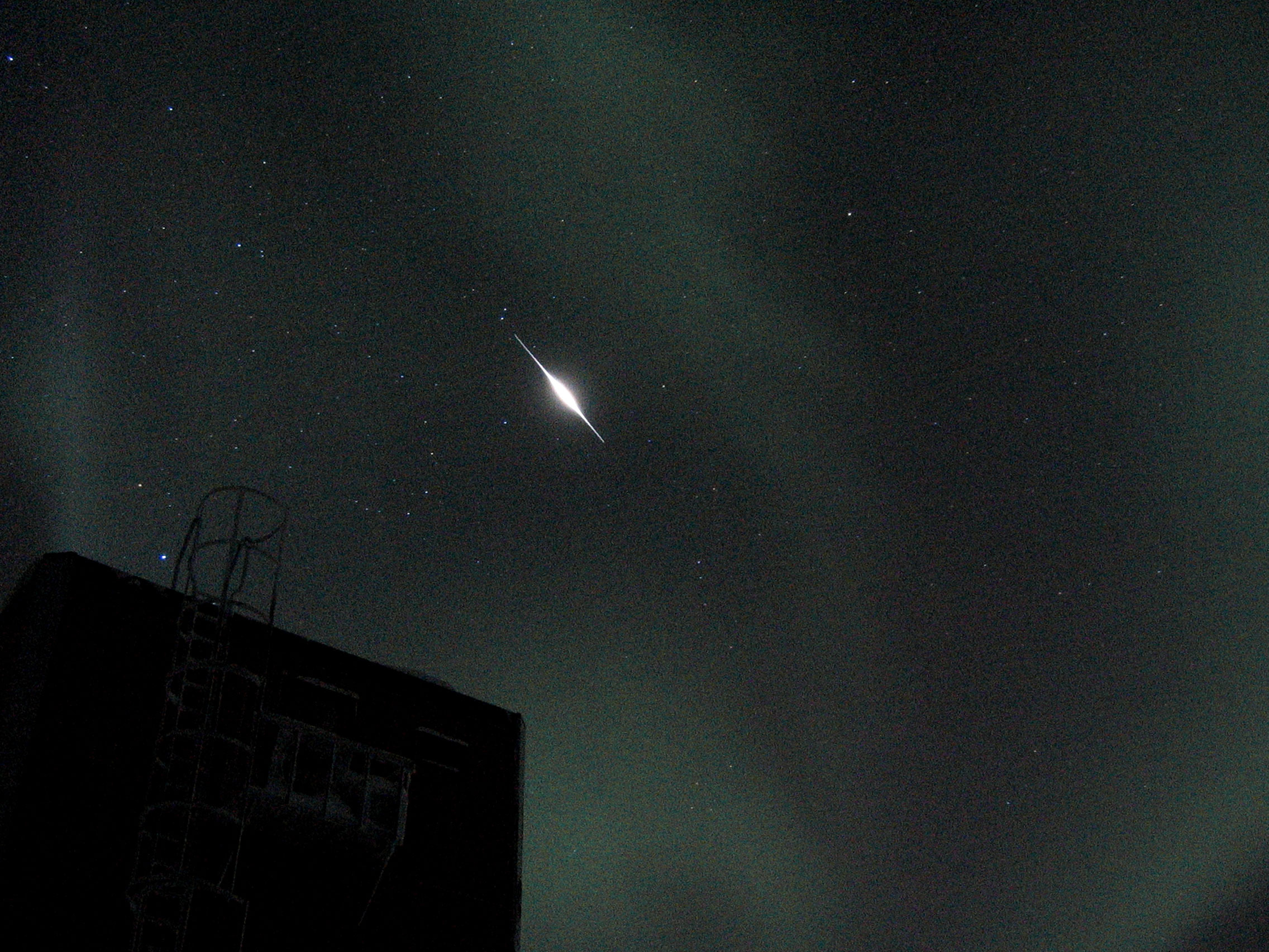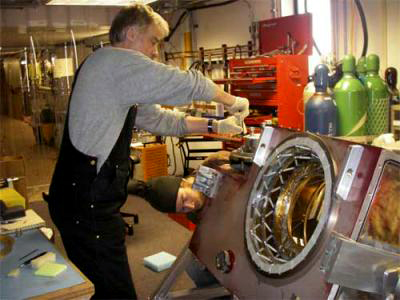|
SPT upgrades sensorsScience team spent summer tweaking telescope capabilities for upcoming observation seasonPosted March 7, 2008
Dana Hrubes is no stranger to wintering at the South Pole. But this time around, the veteran research engineer has a big project on his hands, one that hopes to answer some of the most perplexing questions about the universe. He and fellow winter-over Keith Vanderlinde, who recently completed his doctorate in cosmology and astrophysics from the University of Chicago, will spend the next eight months ensuring the 300-ton South Pole Telescope (SPT) stays on task, searching out galaxy clusters, which represent the largest conglomeration of matter in the universe. “I’m really looking forward to this,” said the soft-spoken Hrubes. “I really think it’s an important project in cosmology, and it’s nice to be part of it. Just to work on something of this scale is interesting and challenging.” The South Pole Telescope — or 10-meter telescope, as some refer to it because of the size of its main dish — was constructed during the 2006-07 austral summer. That represents about 100 days in which scientists, engineers and steelworkers built and tested the seven-storey-high instrument before the dark and cold winter arrived. (See Sun writer Steve Martaindale’s suite of articles about the SPT construction, the science, and why it’s all happening at the South Pole written during the 2006-07 season.) The following winter, the telescope achieved what scientists call “first light” (meaning, it worked), found two quasars (bright objects that may represent massive, radiation-emitting black holes at the center of a galaxy), and spied some small, dark spots that represent galaxy clusters. “It is very clear that we are seeing the sky,” said Stephan Meyer, a co-principal investigator on the SPT from the University of Chicago, one of nine institutions collaborating on the project. Meyer and a number of other SPT team members returned to the South Pole this past summer season to make upgrades to the telescope, including replacing an array of nearly 1,000 detectors, something they’ll likely do every year as the technology improves. “One thing about detectors is that you’re never 100 percent happy with them, because there’s always going to be something better,” said Meyer, while sitting at a computer in the telescope’s noisy control room. “Of course, the real problem is that you get exactly three months to do all of this,” he added, gesturing to the disarray of the room. “It’s quite a bit of logistics.” The upgrade is not unlike buying the latest and greatest digital camera, though the SPT detector doesn’t capture images that make cool screen savers for your computer. Instead, the detector catches changes in radiation, miniscule dips in temperature from the cosmic microwave background (CMB), a nearly uniform hiss of microwaves left over from the Big Bang. The Big Bang, you’ll recall, is the spark that ignited the universe. The SPT can pinpoint galaxy clusters because when photons (light particles) pass through these dense points of matter, they create those dips in temperature against the cold background of space. “Galaxy clusters are nice because they are sign posts, and their distribution, distance, tells you something about the geometry of the universe,” Meyer said. Mapping those galaxy clusters is only the first step toward a long-term goal, he added. “What we’re after is the dark energy.” The theory of dark energy has only been around for about 10 years, but most scientists believe it makes up roughly 70 percent of the universe. The rest of the universe consists of matter (about 5 percent) and something more mysterious called dark matter (about 25 percent). Dark energy is important because it explains the current expansion and acceleration of the universe. Dark energy appears to exert a pressure, counteracting the gravitational attraction between galaxies — creating a sort of tug of war on matter and dark matter between gravity and dark energy. “We can understand everything that’s happened since inflation — when the universe rapidly expanded right after the big bang in fractions of a second — by postulating that gravity and dark energy are affecting the evolution of the universe,” Meyer said. Confirming the existence of dark energy, and characterizing its properties, would be a significant step forward for cosmology. It would constrain models of evolution of the universe, particularly in its latter stages as dark energy apparently exerted more influence. Meyer said it would take about two winter seasons of observations across a wide swath of sky to capture the data on galaxy clusters that the cosmologists need. To understand more about the universe in its infancy, the SPT will eventually change its mission to map out the polarization of the CMB — the direction that photons traveled about 400,000 years after the big bang during a time called recombination. That’s when the universe cooled enough to allow electrons to combine with nuclei. It’s also when the light of the CMB started to expand with the growth of the universe. By studying the pattern of the polarization of the CMB, scientists may be able to detect the faint traces of gravitational radiation that is thought to have been generated as a result of the inflationary epoch. This would provide a long-sought-for characterization of inflation. More Information
“We’re in the process of building a second instrument, one that will be polarization sensitive,” Meyer said. The science intrigues someone like Hrubes, a sort of jack-of-all-trades when it comes to maintaining such complex instrumentation, with a graduate degree in aeronautics and astronautics from MIT. In his previous three winters, Hrubes worked as a research associate, charged with overseeing a host of different projects at the South Pole. He and Vanderlinde, both new to the SPT program, got a crash course in the telescope’s operation and systems over the short summer season. There’s no “SPT for Dummies” manual that they can rely on to troubleshoot problems. So they had to absorb what would amount to a shelf full of Ph.D.-level thesis material in a few, short months. “I did a lot of homework before I came down,” Hrubes said. “There is a lot of interaction back with Chicago and Berkeley [the lead universities], and they have a lot of control over the systems, too.” The veteran winter-over will also serve as the lead for the science community at the station over the winter. In that role, he also feels a responsibility to share his passion of the night sky with others. The telescope is located about a kilometer from the main station building, meaning Hrubes and Vanderlinde will venture outside all winter long — even when temperatures plunge to minus 100 degrees Fahrenheit. “I love walking outside,” Hrubes said. “I try to take [people] out and show them the science we are working on as well as the auroras and iridium flares — iridium satellites that reflect the sun at certain time.” NSF-funded research: John Carlstrom, University of Chicago. |



For USAP Participants |
For The Public |
For Researchers and EducatorsContact UsNational Science FoundationOffice of Polar Programs Geosciences Directorate 2415 Eisenhower Avenue, Suite W7100 Alexandria, VA 22314 Sign up for the NSF Office of Polar Programs newsletter and events. Feedback Form |



.jpg)
